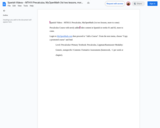
Precalculus Course with newly added video content in Spanish in weeks 01 and 02, more to come.
- Subject:
- Calculus
- Mathematics
- Material Type:
- Lecture
- Lesson
- Author:
- Jack Green
- Date Added:
- 04/07/2023

Precalculus Course with newly added video content in Spanish in weeks 01 and 02, more to come.

A Guide for Language Learners
Short Description:
This open educational resource is created for language learners who want to make independent decisions on the politics over their bodies and identities and determine how they would like to be called while learning Spanish. The material can also serve teachers and professors as a resource to help navigate this challenging topic of our current times. This guide allows the learner to gain a basic understanding of Spanish grammar and its relationship to gender in an independent way. It intends to be not only a resource to decide how you would like to be named but also to understand the complexity of the subject, in relation to Spanish-speaking societies.
Word Count: 2760
(Note: This resource's metadata has been created automatically by reformatting and/or combining the information that the author initially provided as part of a bulk import process.)
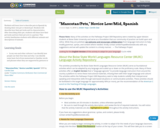
Students will learn how to describe pets in Spanish by drawing their own pet or desired pet. Students will describe how their pet looks and its characteristics. After describing their pet, students will share how their pet looks and how their pet acts to a partner. This activity familiarizes students with different animals and descriptions of animals.
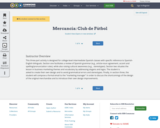
This three-part activity is designed for college-level intermediate Spanish classes with specific reference to Spanish-English bilinguals. Section one facilitates a review of Spanish grammar (e.g., article-noun agreement, accent and spelling/pronunciation rules), while also raising cultural awareness (e.g., stereotypes). Section two situates the lesson in business marketing themes and vocabulary by addressing slogans and logos. The student is asked to create their own design and to avoid grammatical errors and stereotypes. Finally, in section three, the student will compose a formal email to the "marketing manager" in order to discuss the shortcomings of the design of the original merchandise and to introduce their own design improvements.
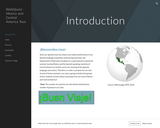
Attention high school Spanish teachers! This is a Webquest that I created to be used as a group project in a High School Spanish I class. It is a cultural learning project spanning three weeks for classroom groups composed of four students. Within each group, each student will carry out one of four different roles/tasks in preparation for an imaginary trip that the class is going to make to Mexico and Central America. Each group will have the option of choosing to research one of the seven countries included, which can accommodate a classroom of up to 28 students under the parameters given. The nice thing about this project is that each group will give a presentation on a different country which will broaden the students' cultural knowledge of Mexico and Central America. This project is intended for high school Spanish students but could also be used for middle school. The only technology needed is a computer, projector, and an internet connection. ¡Que lo disfruten!

This OER Mock Job Interview rubric was created by Jill Camargo and as part of the 2024 World Language OER Summer work and training. Educators worked with Chrystal Liu, Nick Ziegler and Dorann Avey to create OER Learning Plans and materials. The attached Lesson Plan is designed for 9 - 12 World Language Arts teachers for Novice Learners of Spanish. Students will particpate in a semi-authentic job inteview exchange in order to deepen their understanding of using the language and develop their career readiness. This Lesson Plan addresses the following NDE World Language Standard(s): NE.WL.1.1.D, NE.WL.1.3.D, NE.WL.4.1.D It is expected that this Activity will take students 30-45 minutes to complete.

Contains teacher cover sheet and an example/artifact.

Una colección de textos para el debate
Short Description:
Una compilación de textos escritos por autoras (latinoamericanas, españolas y latinas) que manifiestan un interés especial por la cuestión medioambiental. Estos textos y las actividades de comprensión y reflexión que los acompañan contribuyen: i) a familiarizarse con varias categorías relevantes del feminismo y del ecofeminismo y ii) a explorar, desde una perspectiva ecofeminista, algunos temas recurrentes en la literatura escrita por mujeres.
Long Description:
La feminización de la naturaleza y la naturalización de la mujer son referentes comunes en diversas culturas. ¿Cómo se aproximan las mujeres a esta asociación? ¿Cómo hablan del medioambiente y de los goces y las problemáticas que este les trae? En este libro prestamos oído a voces de mujeres que se expresan sobre la cuestión. Presentamos una compilación de textos escritos por autoras (latinoamericanas, españolas y latinas) que manifiestan un interés especial por la cuestión medioambiental.
Este libro ofrece la posibilidad de que los estudiantes se familiaricen con conceptos relevantes en el debate feminista y ecofeminista actual, caso de los cuidados, la ecodependencia, la interdependencia y la explotación de los recursos naturales y sociales. Asimismo, contribuye a revisar, desde una perspectiva ecofeminista, algunos temas recurrentes en la literatura escrita por mujeres, caso de la maternidad, el cuerpo y la sexualidad femenina, la violencia, la justicia y la igualdad.
El libro incluye autoras del canon literario español, latinoamericano y latino, además de un amplio repertorio de nuevas voces. La selección busca visibilizar el discurso público elaborado por las mujeres en un contexto social en que persiste su silenciamiento.
Word Count: 71183
(Note: This resource's metadata has been created automatically by reformatting and/or combining the information that the author initially provided as part of a bulk import process.)
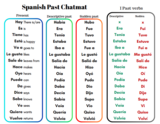
This OER Narrative Chatmat was created by Marcy Fuentes and as part of the 2024 World Language OER Summer work and training. Educators worked with Chrystal Liu, Nick Ziegler and Dorann Avey to create OER Learning Plans and materials. The attached Chat Mat is designed for 6 - 12 World Language Arts teachers for Novice to intermediate Learners of Spanish. Students will use this resource for conversation and writing activities. This Lesson Plan addresses the following NDE World Language Standard(s): NE WL 1.1, 1.2, 1.3This resource is to be used as an activity/scaffold. There is an English template and a Spanish chat mat. **Other languages can edit for their needs using the link to Canva Narrative Chatmat.
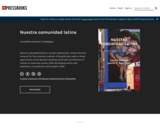
Short Description:
Nuestra comunidad latina is an open educational, content-forward resource for first-semester students of Spanish that seeks to foster appreciation of the Spanish-speaking world and contributions of Latinos to American society while developing novice-mid proficiency in productive and receptive skills.
Word Count: 19833
(Note: This resource's metadata has been created automatically by reformatting and/or combining the information that the author initially provided as part of a bulk import process.)
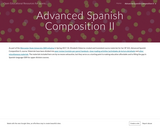
As part of the Worcester State University OER initiative in Spring 2017, Dr. Elizabeth Osborne created and translated course materials for her SP 322, Advanced Spanish Composition II, course. Materials have been divided into peer review (revisión por pares) handouts, close reading activities (actividades de lectura detallada) and other miscellaneous materials. The materials included here are by no means exhaustive, but they serve as a starting point to making education affordable and to filling the gap in Spanish-language OER for upper division courses.

A second-year intermediate course that includes vocabulary enhancement and limited review of selected points of grammar. Focuses on listening comprehension and speaking, with group activities, discussions and individual oral reports based on readings, films, music and art.
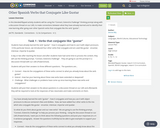
In this blended/flipped activity students will be using the "Connect, Extend & Challenge" thinking prompt along with a discussion thread on our LMS, to make connections between what they have already learned and to identify their new learning after going over other Spanish verbs that conjugate like the verb "gustar". (ACTFL Standards: Connections - 3.2 & Comparisons - 4.1)

Los estudiantes de primer grado escuchan la lectura de un libro de cuentos ilustrado, van a una caminata en la naturaleza y leen un cuadernillo que presenta información que les sirve para su propia historia. Luego se les invita a escribir sobre como es ir a visitar un bosque. También pueden visitar un bosque cercano. Cuadernillo de lectura que acompaña la tarea de desempeño.

Los estudiantes miran un video, leen el cuadernillo y usan su experiencia propia para escribirle a sus amigos, una carta con informacion que contesta la pregunta: "¿Qué es un estuario y qué lo hace tan especial?" Cuadernillo de lectura que acompaña la tarea de desempeño.

Los estudiantes leen un articulo, miran un video y toman notas de estos dos recursos de los que aprenden sobre contaminación del agua pluvial y como prevenirla. También aprenden la frase "que no baje agua sucia al drenaje" y escriben un ensayo para informar a otros estudiantes sobre la importancia del agua limpia para tener peces sanos.

Los estudiantes leen un articulo, miran un video y exploran una guía de campo de bolsillo y luego responden tres preguntas de investigación. Después, conducen un inventario biológico (bioblitz) y escriben un ensayo explicando lo que es un inventario biolgico o bioblitz.

Diseñado para proveer informacion básica sobre energía renovable incluyendo qué es, cómo funciona y las ventajas y desventajas para el ambiente. Cada tarea de desempeño enfoca en un tipo de energía renovable, incluyendo información básica y con suficiente información para escribir ensayos de persuasión. La tarea de energía renovable y no renovable culmina con un discurso. Los maestros cuentan con una rúbrica para calificar el discurso como pracita del SBAC. Se proporciona una plantilla para preparar los discursos.

Los estudiantes de tercer grado leen un artículo y miran un video sobre cómo empezar una hortaliza. Toman notas de estas dos fuentes y escriben un ensayo de información para explicarle a otra clase cmo empezar su propia hortaliza.

Los estudiantes de K-2 usan la información que se presenta en el cuadernillo, miran un video y utilizan lo que han aprendido, para escribirle una carta a sus amigos, explicando cómo estará el tiempo y cómo deben vestirse apropiadamente. Cuadernillo de lectura que acompaña la tarea de desempeño.